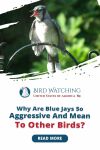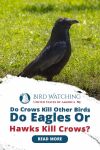
What’s This Post About?
Blue jays, crows, and ravens all belong to the Corvid family and are brilliant and inquisitive birds. They are very skilled at surviving as they adapt to new situations and environments quickly.
They have many talents, including using various tools when required and mimicking the sounds of other creatures.
Although crows and ravens are often associated with death, blue jays are considered beautiful, harmless birds. This is a huge misconception which this post will explore and explain.
Blue jays are territorial and aggressive birds that are not afraid of attacking any bird or creature. They are known for attacking predators or driving away other birds away from bird feeders to have all the feed for themselves.

Reasons For Blue Jays’ Aggressive Behavior
For a bird as beautiful as a blue jay, one might wonder what makes these birds aggressive? Multiple reasons make these little birds appear hostile. Read on to learn about some of the common reasons.
1. Territorial
Blue jays don’t like it when they think that their territory is under threat. They like having their space, and if they feel that some other bird is trying to take over it, they respond in a very hostile manner.
2. For Food
Food is an essential factor for aggression in many birds. Blue jays, in particular, drive away multiple birds from bird feeders so that they can have a larger share of the food.
They are intimidating birds who aren’t afraid of harming another bird, making it easy for them to keep food and territory for themselves.

3. If They’re Feeling Threatened
When blue jays are feeling threatened, they attack the animal that is making them feel unsafe.
Notably, hawks are one of the birds that blue jays feel threatened by, so they feel the need to be aggressive towards them and get rid of them.
4. Mating Season
Blue jays are monogamous birds that only breed with one partner throughout their life. Usually, the males are more aggressive than the females as they tend to be more territorial and need to defend their partner from predators.
But before mating season, their female counterparts become more aggressive. Many believe this is because the female blue jay requires more nutrients before mating and because of their natural drive for mating.

Methods Of Attack and Deceit
1. Mimicking
Blue jays are incredibly talented at mimicking the sounds that they hear. This includes mimicking the sounds of humans, animals, or other birds.
This is how they often get other birds to leave the feeding station to have it all for themselves.
They mimic the sound of a hawk which scares the other birds, and they leave. However, this ability is also used positively many times.
Whenever they see a predator such as a hawk nearby, they will sound the alarm to let other birds know that the area is now unsafe. This allows the birds to escape before being devoured by the predator.

### 2. Creating A Mob
Since there is strength in numbers, blue jays often create mobs. They join other blue jays to attack a target that might’ve made them feel threatened.
They will gather together to fend off a hawk or even a cat. This is often done by many species of birds, such as crows.
Other than this, these birds collectively drive out other birds present at the bird feeder so that they can have access to more food and have space all to themselves. They are brilliant birds who will do whatever it takes to survive.
3. Eating Baby Birds
Although blue jays eat the nuts and fruits you leave out in your bird feeder, they also tend to eat the young or eggs of other birds.
This nest predation makes them highly violent and threatening creatures. However, it is essential to note that nest predation doesn’t occur too frequently.

4. The Use of Make-Shift Tools
Researchers have observed blue jays using different make-shift tools to help them obtain their food. They will use any material available to them such as newspapers or clips to help them gather their food.
Blue Jay-Proof Bird Feeders
Blue jays are dominating birds at the bird feeder. They like taking over the bird feeder, and they eat almost anything you put in your feeder. They eat items like sunflower seeds, fruits, nuts, and bread.
Many people like having them in their backyard as they are stunning, and they don’t seem to realize how troublesome they can be.
They do not like squirrels or chipmunks, which is why they prefer the bird feeders without them. They only let bigger birds near their feeder sometimes, but they like having it to themselves.

You can prevent blue jays from coming to your feeder by replacing your old feeder with a newer and smaller one. This will make it hard for the blue jays to perch on it. Thus, they won’t be able to deny other birds access to it.
You can shift to a squirrel-proof feeder to stop bigger birds from eating out of your feeder. This will require some effort on your part because you will purchase it.
You can explore the Joy Bird House Window Feeder.
Wild Birds of Joy Bird House Window Bird Feeder
Where most feeders only come with 3 suction cups with moderate adhesion, this feeder is specially designed to come with four extra strong suction cups.
The downside of using these two methods is that you will deny larger birds’ food from your feeder. The feeder will only be accessible for smaller birds, and you will be limiting the types and number of birds in your backyard.
Types Of Blue Jays And Their Habitats
Blue jays can be found in Eastern and Central United States and north into South-central and Southeast Canada. They can survive in various environments and habitats because they are very adapting.
The blue jay can be divided into four subspecies:
-
Northern blue jay (Northeastern United States and Canada)
-
Coastal blue jay (North Carolina-Texas)
-
Interior blue jay (middle of the United States)
-
Florida blue jay (Southern Florida)
The type of subspecies a blue jay belongs to depends on its habitat and color.

Keep Reading!
Blue jays are brilliant birds who will do whatever necessary to survive. They can easily survive and adapt to new environments. They have several methods of getting food away from other birds and driving them away from their food.
They can mimic sounds that they hear that make other birds believe that there is a predator nearby. In fear of being eaten, these birds fly away, leaving all the food for the blue jays to eat.
They are even smart enough to use various tools to assist them when they’re collecting food.
However, these birds can be pretty ruthless sometimes and can go as far as eating another bird’s baby. They are nest predators, and they eat eggs as well as baby birds. They are frequently aggressive with other birds.
If they believe that they are being threatened or that their territory might be infiltrated, they take extreme measures such as attacking the birds responsible by creating a mob with other blue jays.
In this post, your misconceptions about blue jays must have been cleared, and you now may know why blue jays tend to get aggressive and the variety of ways they can use to deceive other birds.
Granted that they are beautiful birds, they are just as dangerous, and you should be careful.
If you’re interested in reading up more about blue jays, here are some 38 facts you can explore.
38 Amazing Blue Jay Facts You Probably Didn't Know (2021)
Intrigued to learn more about the robustious Blue Jay, whose noisy chattering prevails outside your yard? Read ahead to discover staggering facts!

By David A. Swanson
Bird Watching USA
My name is David and I'm the the founder of Bird Watching USA! I started Bird Watching with My father-in-law many years ago, and I've become an addict to watching these beautiful creatures. I've learnt so much over about bird watching over the years that I want to share with the world everything I know about them!

David A. Swanson
Bird Watching USA
My name is David and I'm the the founder of Bird Watching USA! I started Bird Watching with My father-in-law many years ago, and I've become an addict to watching these beautiful creatures. I've learnt so much over about bird watching over the years that I want to share with the world everything I know about them!










